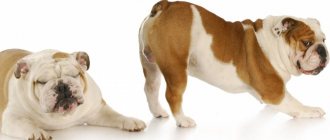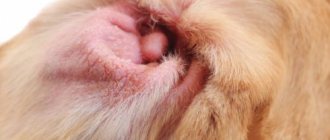Some “intimate” problems associated with digestion can affect not only humans. Pets suffer from them only slightly less often. For example, a dog has gas. This pathology causes many problems both for the pet itself and for its owners. Let’s say, it’s not easy to live in the same apartment with a dog who… every minute “spoils the air” and at the same time resembles an inflated balloon.
Flatulence, as a by-product of bacterial fermentation, often develops due to poor-quality feeding of the animal. Various dietary fibers, complex carbohydrates, overeating or a sudden change in diet are the main predisposing factors. Boxers, bulldogs, Boston terriers and some other brachycephalic breeds are also thought to be inherently predisposed. But not only pure flatulence can be the result of problems with feeding or digestion.
Causes of flatulence in dogs
The formation of gases in a dog's stomach and intestines is called flatulence. When this gas escapes, the dog burps and farts. It would seem nothing supernatural, but the constant problem with increased gas formation causes considerable discomfort to the owner and all family members.
The first thing to consider is the formation of gas in the stomach and intestines; this is a completely natural process. Moreover, the formation of gases during the digestion of food indicates normal functioning of the gastrointestinal tract. It is by the presence of gases in the stomach, belching or “farting” that the “starting” of the gastrointestinal tract is determined after abdominal surgery.
Flatulence is a problem when it is chronic - the volume of gases increases sharply and they acquire a distinct, foul odor. In addition, the dog's abdominal cavity swells, which causes discomfort.
The most common causes of flatulence in dogs are:
- Binge eating.
- Eating unusual food.
- Eating spoiled foods.
If your dog is constantly experiencing flatulence, the most likely cause is an unbalanced diet. Simply put, the food you feed your dog is not fully digested in the gastrointestinal tract. Products that are not completely digested begin to ferment as they move into the large intestine, resulting in the release of gases.
Note! Dogs that are obese or lead an inactive lifestyle are prone to chronic flatulence.
Common causes of flatulence include hasty eating or overeating. This may be due to improper placement of bowls or incorrect feeding schedule. Some dogs are naturally prone to hasty eating; for them, special bowls with a high, structured bottom become a solution to the problem.
Is it possible to prevent bloating?
There are many theories about preventing bloating.
However, scientific research over the years has contradicted many methods. One of the surest ways to prevent bloating is through a prophylactic gastropexy, a elective surgery in which the stomach is attached to the body wall. This can often be performed during a routine spay or neuter of a young dog. Prophylactic gastropexy is very effective in preventing bloating, but can also be quite expensive. Some surgeons also offer laparoscopic gastropexy.
This procedure involves inserting rigid cameras through tiny incisions. It is less risky than traditional surgery, but may be more expensive. Prophylactic gastropexy is usually only recommended for dogs at high risk for bloat. Talk to your veterinarian about the options available for your dog.
Other preventative measures are being discussed. Not all experts agree on the effectiveness of the following methods, so please discuss them with your veterinarian:
- Eating two or more meals a day
- Eat more slowly (some dog bowls are designed to slow down eating, but don't always work)
- Avoid vigorous exercise after meals
- Adding canned food to your regular diet
- Lifting food and water bowls (some studies suggest this may actually increase the risk of bloating)
Aside from prophylactic gastropexy, the most important thing you can do is monitor your dog closely. Watch for any changes or signs of illness and report them to your veterinarian. Once again, the importance of discussing prevention with your veterinarian cannot be overemphasized.
Diseases accompanied by the release of gases
Diseases accompanied by the release of gases are very common and numerous, but in most cases they are associated with nutrition and care.
First, you need to make sure that the dog is suffering from flatulence:
- Your dog farts regularly, and the gas may be odorless or cause severe discomfort.
- The dog experiences abdominal discomfort.
- The pet has abdominal distension.
- You notice that your pet's stomach often growls.
With flatulence, the dog may experience associated problems that are expressed by various symptoms.
Probiotics
The main problem with bloating is the death of beneficial intestinal microflora, without which the dog will not have normal digestion in principle. The only way out is to repopulate the intestines with “positive” microbes . This can be done by giving your dog probiotics. The name of this group of drugs is made up of two words. “Pro” - which means “for”, and also “bios”, which means life. Simply put, these are medicines “for life”. More precisely, they contain colonies of beneficial symbiotic microorganisms. Even giving them to your pet once can significantly alleviate his condition with dysbacteriosis and severe bloating.
One note - probiotics should only be purchased in liquid form. Studies have shown that drugs produced in capsule form contain a maximum of 2-5% of living microorganisms.
Additional symptoms and what they mean
For a quick and accurate diagnosis, it is extremely important to notice additional symptoms and know what they mean.
Additional symptoms include:
- Diarrhea.
- Nausea and vomiting.
- Avitaminosis.
- Deterioration in the quality of wool and skin.
- Weight loss against the background of habitual food consumption.
If you notice additional symptoms that regularly bother your dog, it is better to consult a veterinarian. If for some reason you cannot go to a veterinary clinic, you can identify the underlying diseases using the method of exclusion.
Strong unpleasant odor
A strong unpleasant odor against the background of flatulence clearly indicates the process of rotting in the intestines.
Rotting food can be caused by:
- Dysbacteriosis.
- Unbalanced feeding.
- A number of viral and bacterial diseases.
The dog needs to be put on a diet and the dynamics observed, provided that its temperature and health are normal.
If you notice that your pet has become lethargic and refuses food or water, immediately consult a doctor.
Rumbling in the stomach
Rumbling in the stomach is quite natural if it does not cause discomfort. With increased gas formation, the dog may experience stabbing pain. To relieve this condition, any drugs that “bind” gases are used, for example, Espumisan.
Diarrhea
Diarrhea can be a natural reaction of the body to eating low-quality or unusual food. If flatulence and diarrhea are chronic, there is a serious threat of dehydration and deterioration in the dog’s health.
It is important to understand that diarrhea due to poisoning and intoxication is strictly not recommended to be stopped with medication. If you cannot contact a veterinarian, put your dog on a starvation diet and observe the dynamics. During the day, give your dog adsorbents and coating preparations.
Vomit
Vomiting is a natural method of cleansing the body when there is a threat of intoxication or eating something that the dog cannot digest. If vomiting occurs once, the dog remains active and has retained its appetite, most likely the reason is poor quality feeding.
If you notice that your dog is constantly sick and vomiting more than 2-4 times a day, be sure to contact your veterinarian. Profuse vomiting and severe nausea may indicate infection with viral diseases.
The dog doesn't go to the toilet
If your dog has a swollen belly and does not go to the toilet, the reasons may be the following:
- Severe helminthic infestation.
- Constipation.
- Intestinal blockage.
To prevent intestinal blockage by helminths, prophylaxis is carried out once every 3 months, regardless of the season of the year. Treatment for constipation directly depends on its causes, so it is best to consult a veterinarian. Intestinal blockage is a rapidly developing, life-threatening condition that is difficult to diagnose.
Note! Neoplasms in the intestines can lead to constipation due to flatulence. This problem cannot be diagnosed and treated at home.
Flatulence during pregnancy and after childbirth
Flatulence during pregnancy and after childbirth is considered a natural consequence of “rebuilding” the body. As puppies grow, they begin to put physical pressure on the gastrointestinal tract, which can lead to the development of diarrhea, constipation and other problems.
The health of a pregnant dog must be carefully monitored, and if dangerous symptoms appear, immediately consult a veterinarian. If flatulence is caused by natural causes, it is better to switch the dog to a light but nutritious diet until the body recovers after childbirth.
Forms of pathology
Bloating is just a symptom, not an independent disease. It cannot be cured without eliminating the root cause. Depending on the severity of the accompanying symptoms, there are 2 forms of this pathological condition: acute and chronic.
Acute
The acute form occurs suddenly and is accompanied by severe discomfort. Due to pain, the pet may whine restlessly and arch its back. Symptoms quickly increase and are complemented by:
- decreased or complete loss of appetite;
- diarrhea and foamy vomiting with mucus or blood clots;
- breathing problems, shortness of breath;
- bulging eyes;
- hiccups and belching;
- loss of coordination and limb failure;
- blue mucous membranes.
Most often, this picture occurs when there is excessive gas formation, excess air or liquid. All these conditions put pressure on internal organs and can lead to death. To save the four-legged animal, emergency surgery may be required.
Chronic
The chronic form of the pathology occurs unnoticed for both the owner and the pet. It can only be detected during an examination at a veterinary clinic or at the time of relapse, when the symptoms become more pronounced. This picture is typical for gastrointestinal pathologies, kidney diseases and hormonal disorders.
What foods cause flatulence?
Let's figure out which foods cause flatulence:
- Corn.
- Legumes, especially peas.
- Whole milk and fermented milk products - increased gas formation indicates intolerance or a violation of the intestinal microflora.
- Fat and other high-fat foods.
- Any products with spices.
Approximately 40% of adult dogs are lactose intolerant. In this case, immediately after drinking whole milk, the dog develops severe flatulence and diarrhea. To eliminate unpleasant consequences, whole milk is replaced with homemade fermented milk products.
Increased gas formation from dry food
Increased gas production from dry food is a very common problem. The fact is that feed is divided into classes that indicate quality. The lower the grade of food, the more likely it is to contain legumes, corn, soy and vegetable fats. All these products provoke the development of flatulence and dysbacteriosis.
If increased gas formation begins to bother the dog after switching to dry food, there may be two reasons:
- Inappropriate diet composition.
- Too abrupt a transition to a new diet.
For everyday feeding of dogs, it is recommended to feed at least super premium food that does not contain corn, wheat, peas and other legumes. In addition, the dog may have an individual intolerance to any components of the food. If you are sure that flatulence is associated with dry food, try switching your dog to products from another manufacturer.
The dog's body needs some time to adapt to a different type of food. When switching from natural food to dry food, you need to act progressively. At the first stages, dry food is soaked and mixed with the usual food. After 5-7 days, the dog gradually switches to dry granules. When transferring from one dry food to another, within 3–5 days, the new food is mixed with the usual one.
What to do and how to help your pet
Flatulence is almost always a symptom and therefore cannot be treated as an independent disease. In order to help the dog, it is necessary to determine the root cause and treat it.
To alleviate the condition, dogs use a diet that is easily digestible and contains a small amount of fiber and fat.
If the veterinarian determines that the dog’s condition is chronic, in addition to diet, the pet is prescribed complex therapy. To quickly eliminate discomfort in a dog, special nutritional supplements are used, including those containing probiotics.
When to see a doctor
You should contact a specialist for help when:
- rumbling is accompanied by pain in the dog;
- there is a suspicion of helminthic infestations;
- loss of appetite;
- the stomach is very bloated, the dog looks tense;
- the pet develops digestive problems, manifested in vomiting, diarrhea, constipation;
- Together with the listed symptoms, the animal is lethargic, apathetic, loses weight, and there is bloody discharge in the stool.
Making the right diet for your dog
Provided that the pet does not suffer from food allergies or individual intolerances, those foods that cause fermentation should be excluded from the diet. When we are preparing the correct diet for a dog suffering from flatulence, at least for a while we need to exclude from it:
- Soybeans, peas, beans and heavy grains.
- Sources of coarse fibers, such as bran.
- Yeast.
- Whole milk.
- Anything that contains spices.
- Any products whose quality is questionable.
To help the gastrointestinal tract cope with digestion, all meat and fish products must be boiled.
Meat and fish should not be too fatty. In the process of restoring the mucous membranes and intestinal microflora, broths must be introduced into the dog’s diet.
Since whole milk is completely removed from the diet, it must be replaced with live yoghurts or special nutritional supplements. Tasteless additives in powder form, which are diluted in water, are very convenient.
Risk groups by breed
In most cases, large, barrel-chested breeds suffer from bloat. This feature is typical for:
- St. Bernards;
- Dobermans;
- Labradors;
- German Shepherds;
- Rottweilers;
- Great Danes;
- standard (royal) poodles;
- golden retrievers;
- bobtails.
In addition to breed predisposition, there is a relationship with age. The diseases listed above are usually diagnosed in animals over 7 years of age, suffering from chronic pathologies and leading a “sofa” lifestyle.











